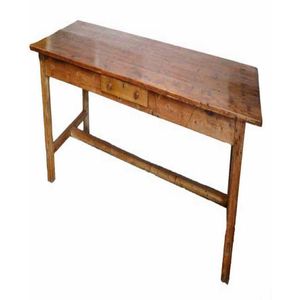Huanghuali Folding Stool, Qing Dynasty
You must be a subscriber, and be logged in to view price and dealer details.
Subscribe Now to view actual auction price for this item
When you subscribe, you have the option of setting the currency in which to display prices to $Au, $US, $NZ or Stg.
- Huanghuali Wood - Huanghuali is the most sought-after timber used in the construction of Chinese furniture because of its fine colour and grain.
During Ming and early Qing dynasties, most of the best furniture was made from huanghuali wood.
It is a member of the rosewood family and over time the surface mellows to a yellowish brown tone with the exposure to light.
In recent years, furniture made from huanghuali wood has increased exponentially in value. - Ming Dynasty - The Ming Dynasty was a ruling dynasty of China from 1368 to 1644. It succeeded the Yuan Dynasty and preceded the Qing Dynasty. The Ming Dynasty was established by Zhu Yuanzhang, a former Buddhist monk who became a rebel leader and eventually overthrew the Mongol Yuan Dynasty. During the Ming Dynasty, China experienced a period of relative stability and prosperity. The government was centralized and bureaucratic, with the emperor at the top of the hierarchy. The Ming Dynasty is known for its cultural achievements, including the development of porcelain, the invention of movable type printing, and the construction of the Great Wall of China.
- Qing Dynasty - The Qing Dynasty was the last imperial dynasty of China, ruling from 1644 to 1912. It was established by the Manchu people, who originated from the northeastern region of China. The Qing Dynasty was preceded by the Ming Dynasty and followed by the Republic of China.
This item has been included into following indexes:
- Chinese furniture, chairs
- Chinese furniture, timbers
- Chinese furniture, type or function - stool stools 147
Visually similar items

Percival Lafer coffee table, sculptured wool with glass top, Brazil, c 1960s, 37 cm high, 119 cm wide, 62 cm deep

A mahogany butlers tray table on stand, 19 th century, 81 cm high, 74 cm wide, 49 cm deep

A Continental Oregon pine refectory style, farmhouse table 18th century and later. The table is pegged construction with a stretcher base, single central drawer with turned knob handles. Height 74 cm. Length 228 cm. Width

Rosando extension coffee table, Blondewood, laminate insert, Australia, c 1950s, 52 cm high, 92 cm wide, 46 cm deep
